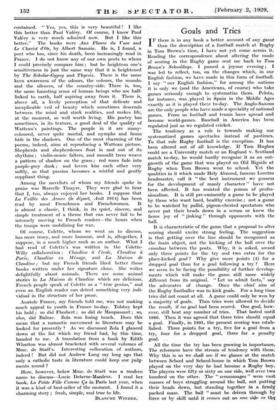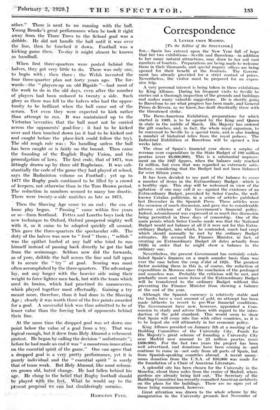Goals and Tries
IF there is in any book a better account of any game than the description of a football match at Rugby in Tom Brown's time, I have not yet come across it. Reading the correspondence about altering the mode of scoring in the Rugby game sent me back to Tom Brown's Schooldays. I passed a joyous evening ; I was led to reflect,, too, on the changes which, in our English fashion, we have made in this form of football. I say " our English fashion," for among the nations it is only we (and the Americans, of course) who take games seriously enough to systematize them. Pelota, for instance, was . played in Spain in the Middle Ages exactly as it is played there to-day. The Anglo-Saxons are the only people who have made a speciality of national games. From us football and tennis have spread and become world-games. Baseball in America has been regulated just as we regulated cricket.
The tendency as a rule is towards making mu systematized games spectacles instead of pastimes. To that rule Rugby football is the exception. It has been altered out of all knowledge. If Tom • Hughes could see a University match or an England v. Scotland match to-day, he would hardly recognize it as an out- growth of the game that was played on. Old Bigside at Rugby when Tom Brown went to school. Yet 'the qualities in it which made Hely Almond, famous Loretto headmaster, call it " the best instrument we possess for the development of manly character " have not been affected. It has resisted the poison of profes- sionalism. It is still pre-eminently a game to be played by those who want hard, healthy exercise ; not a game to be watched by pallid, pigeon-chested spectators who never put their heads down in a scrum or knew the fierce joy of " jinking " through opponents with the ball.
It is characteristic of the game that a proposal to alter scoring should excite strong feeling. The suggestion is that getting over the line should be recognized as the main object, not the kicking of the ball over the crossbar between the posts. Why, it is asked, award only three points for the try and two' extra for the place-kicked goal ? Why give more points (4) for a dropped goal than for a goal following a try ? Here we seem to be facing the possibility of further develop- ments which will make the game still more widely different from its original. " Let us admit facts," say the advocates of change. Once the chief aim of the Rugby footballer was to kick goals. For a long time tries did not count at all. A game could only be won by a majority of goals. Then tries were allowed to decide the result, if no goal had been scored. One goal, how- ever, still beat any number of tries. That lasted until 1886. Then it was agreed that three tries should equal a goal. Finally, in 1891, the present scoring was estab- lished. Three points_ for a try, five for a goal from a try, four for a dropped goal, three for a penalty goal.
All the time 'the try has been growing in importance. The reformers have the stream of tendency with them; Why this is so we shall see if we glance at the match, between School and School-house in which Tom Brown played on the very day he had become a Rugby boy: The players were fifty or sixty on one side, well over two hundred on the other. The " scrummages " were vast masses of boys struggling around the ball, not putting their heads down, but standing together in a firmly packed mass. The ball " must be driven through by force or by skill until it comes out an one side or 04 other." There is next to no running with the ball. Young Brooke's great performance when he took it right away from the Three _Treesto .the School goal was a dribble. He did not handle the ball until it was over the line, then he touched it doWn. Football was a kicking game then: To-day it might almost be known As handball.
When first three-quarters were posted behind the halves, they got very little to do. There was only one; to begin with ; then three ; the Welsh invented the four three-quarter plan not - forty years ago.. The for- wardsthe " players-up on old Bigside "—had most of the work to do in the old days, even after the number of players had been reduced to twenty . a side: Such glory as there was fell to the halves- who had the oppor- tunity to be brilliant .when the ball came out of the scrum. Yet even, they were expected • to kick rather than attenipt to run. It was maintained up to the Victorian 'seventies that the ball must not be carried across- -the .opPOnentS' ; it had to be kicked over -and then touched down (as it had to -be kicked out and caught before the place-kick could follow the try). The old rough rule was : No handling unless the ball has been caught Or is fairly on the bound. Then came the founding of the --English`-Rugby Union, and the Promulgation of lawi. The first code, that of 1871, was fittingly drawn up by three old' Rugbeians. It was sub- stantially the code of-the game they had played at school, says the Badminton volume on Football ; yet up to 1877 the Rugby goals continued to be filled by a crowd of keepers; not otherwise than in the Tom Brown period. The reduction in numbers seemed to many too drastic. There were twenty-a-side matches as late as 1875.
Then the Shoving Age came to an end ; the era of loose play began. " Passing " came within five years or so—from Scotland. Fettes and Loretto boys took the new technique to Oxford, Oxford prospered mighty well with it, so it came to be adopted quickly all around. This gave the three-quarters the spectacular role. The duty of the halves was now to " feed " them ; " selfish " was the epithet hurled at any half who tried to run himself instead of passing back directly- he got the ball from the scrimmage. Seldom now did the forwards, as of yore, dribble the ball across the line and fall upon it to secure the " try " at goal. Scoring was most often accomplished by the three-quarters. The advantage lay, not any longer with the heavier side using their weight to force lighter men back, but with the team which used its brains, which had practised its manoeuvres, which played together most effectually. Gaining a try Meant more, therefore, than it had done in the Shoving Age ; clearly it was worth three of the five points awarded for a goal. A successful kick was thus admitted to be of lesser value than the forcing back of opponents behind their line. . At the same time the drOpped goal was set down one point below the yalue,.of a goal from a try. That was logical enough, but it drew from Hely Almond a vehement protest. He began by calling the decision " unfortunate"; before he had made an end 'it was " a monstrous innovation on the essential spirit of the ganie."_ _ One can agree that a dropped goal is a very; pretty performance, yet it is purely individual and the " essential spirit " is surely that of team work. But Hely Almond, like most reforni- ers grown old, hated change. He had fallen behind his age.: He clung to the beliefRugby football should be played with .ther'feetf, . What he would say to the present proPO441 we can but shudderingly surmise.
HAMILTON FYFE.









































 Previous page
Previous page